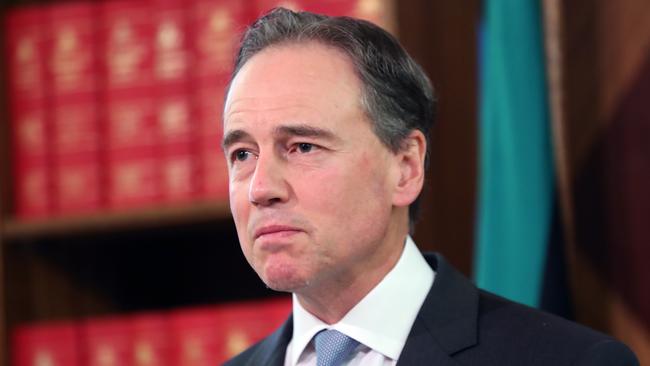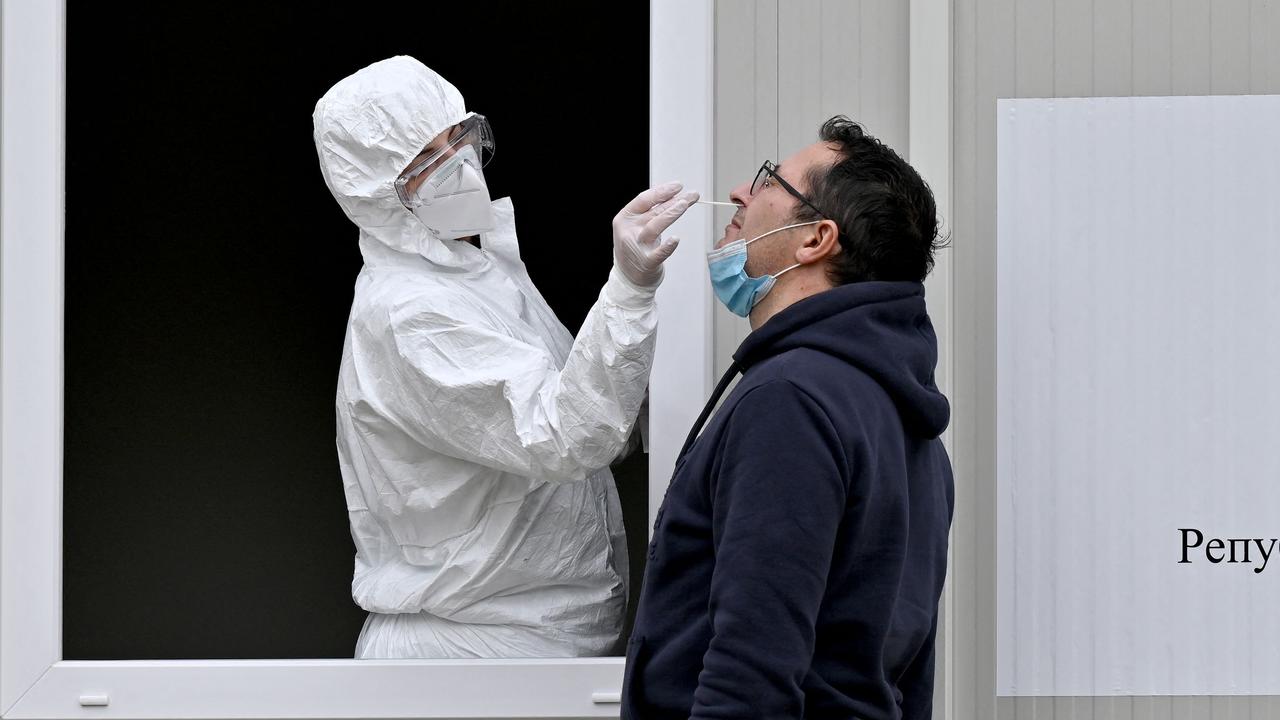Greg Hunt says Australia will be ready to give booster Pfizer shots
Health Minister Greg Hunt has warned “in all likelihood” the top-up vaccines will become as much a part of life as seasonal flu jabs.
Coronavirus
Don't miss out on the headlines from Coronavirus. Followed categories will be added to My News.
Vaccinated Australians will need regular booster jabs to ward off emerging strains of Covid-19.
Health Minister Greg Hunt has warned “in all likelihood” the top-up vaccines will become as much a part of life as seasonal flu jabs.
His comments followed new data about the Pfizer vaccine, released on Thursday, showing a third “booster” dose generated far more virus-neutralising antibodies against the more easily transmissible delta variant.
“Regarding boosters, we’re well prepared,” Mr Hunt said.
“Having secured the supplies across multiple different fronts – Pfizer, Moderns and Novavax – we’re in a position to be able to run a continuous program.”
The timing of the start of the booster program was “purely a medical question,” Mr Hunt said.
“The world will be living with Covid for decades,” he warned.
The timing of the first booster shots could be a delicate issue, with concerns some Australians who were vaccinated first – including Prime Minister Scott Morrison – may require a booster shot before others have even had their first dose.

A non-peer reviewed study undertaken by Pfizer showed the vaccine’s efficacy declined over time, dropping to around 84 per cent effectiveness from a peak of 96 per cent, six months after participants received their second dose.
Pfizer has said vaccine recipients will need a third dose of its jab, which will increase protection against Covid-19 and its Delta strain.
New data about the vaccine, developed with German partner BioNTech, has shown that a third dose generated virus-neutralising antibodies more than five times higher in younger people and more than 11 times higher in older people than from two doses against the more easily transmissible Delta variant.
“All in all, I think a third dose would strongly improve protection against infection, mild moderate disease, and reduce the spread of the virus,” Chief Scientific Officer Mikael Dolsten said on a call to discuss Pfizer’s quarterly results.
Mr Dolsten said the data suggested levels of antibodies could be boosted up to 100-fold when compared to levels before the third dose.
Dr Deborah Cromer, a Senior Research Fellow at the Kirby Institute, said all vaccines dropped in efficacy over time.
“The level of decline in vaccine efficacy is pretty much what we would expect based on research we have done,” she said.
And a vaccine that offered around 85 per cent protection after six months was “still excellent”, Dr Cromer said, and Kirby Institute researchers were predicting Pfizer would offer around 60 per cent protection after 12 months.
The decision about when to start booster shots in Australia “depends on what level of protection you consider acceptable,” Dr Cromer said, “but the highest priority is to get the population vaccinated with at least one dose and preferably two doses”.
The Australian Technical Advisory Group on Immunisation (ATAGI) is expected to advise on the rollout of booster shots soon, but Associate Professor Stuart Turville, also of the Kirby Institute, warned the rate of booster shots may not be the same for everyone.
“Everyone is different and there may be many of us that we identify that will need boosters sooner rather than later,” he said.
“This we will see over time and when all of the global data comes in looking at those vaccinated but still getting infected.”
As Pfizer raised its 2021 sales forecast for its Covid-19 vaccine by 29 per cent to $33.5 billion, it said it could apply for an emergency use authorisation (EUA) for a booster dose as early as August.
Pfizer’s decision earlier this month to seek authorisation for a third dose has sparked criticism from American health regulators.
Many are concerned data does not show there is enough evidence to warrant the need for booster shots.
Pfizer said it has shipped over 1 billion doses of the vaccine since December across the US, Europe and other nations including Australia.
It comes as Pfizer and BioNTech plan to test a version of the vaccine on the Delta variant next month, with the first batch already manufactured.
The variant now accounts for more than 80 per cent of new US cases and has also become dominant in Australia and more than 100 other countries according to the World Health Organisation.
Pfizer Chief Executive Albert Bourla said the company should meet its timeline to apply for an EUA for the vaccine in children under 12 in September.
“We are not changing right now our expectations,” he said.
“If we need to do more in less time, we will try to accommodate that.”
HOW WE MADE THE ASTRAZENECA VACCINE
The makers of the AstraZeneca vaccine from Oxford University have published a new book revealing the five steps they took to make the jab a reality.
In their new book, Vaxxers: The Inside Story of the Oxford AstraZeneca Vaccine and the Race Against the Virus, Sarah Gilbert and Catherine Green revealed they first undertook a new “rapid method” of vaccine production.
They needed a sequence of DNA that coded for the Covid-19 vaccine.
But this method had soon failed. They abandoned it and then went back to their “classic method”, according to a new extract of the book published in The Australian.
“We transfected the cells. After just one day of incubation, we diluted them in order to separate them into individual cells, and introduced each of these individual cells into a new, uninfected culture. Each single infected cell would then produce an independent preparation of the vaccine, which could be expanded and tested to check it was completely correct and homogeneous – a true clone,” they wrote.
“By early March we had picked a favourite clone that was genetically perfect and proliferating particularly well: its name was D8.”
In their second step, they decided to proceed “at risk”, moving to the next stage of the process before all testing was complete on the previous stage.
“If the starting material failed any of its tests, we would have to throw out anything we had made from it,” they wrote.
In their third step they had to purify the vaccine.
“In this step, we get rid of all of the bits of the human cells in which we have grown our viral vaccine, and any badly formed non-functional viral particles, leaving us with pure vaccine. We want the bread, not the tin we baked it in.”
In step four, they began to fill vaccine vials manually inside a clean room.
In their final step, they had to label the vaccines, make sure all documentation was complete to go ahead with trials.
“The final step is certifying that the batch produced is suitable for use in a specific trial. We got our final test results back on April 21 and the next day the batch was certified as ready for use. We were all exhausted.,” they wrote.
Originally published as Greg Hunt says Australia will be ready to give booster Pfizer shots


